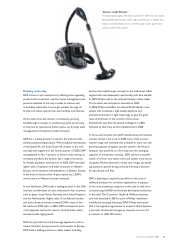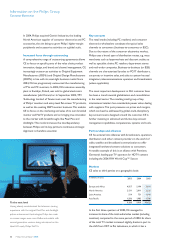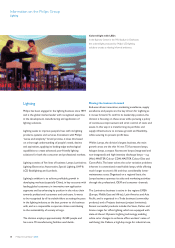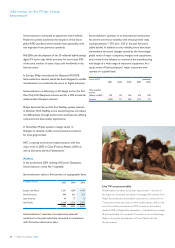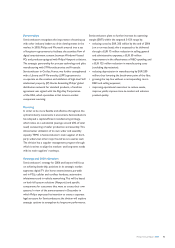Philips 2005 Annual Report Download - page 42
Download and view the complete annual report
Please find page 42 of the 2005 Philips annual report below. You can navigate through the pages in the report by either clicking on the pages listed below, or by using the keyword search tool below to find specific information within the annual report.
Philips Annual Report 200542
Information on the Philips Group
Semiconductors
Becoming a leaner, more agile, market-oriented
business
Effectivetechnologicalinnovationandcapital-efcient
manufacturing – in many cases in partnership with others
– are key elements of the division’s drive to become a less
cyclical,moreconsistentlyprotablebusiness.
Semiconductors’ market share has eroded over the last
decade. The Home area is experiencing a rapid transition
from analog (where Philips has a high market share) to digital
solutions (where Philips has a substantially lower market
share due to the late arrival in digital decoders). This trend
is being addressed by the Business Renewal Program, which
Semiconductors started in May 2005. This is intended to
make the division a simpler, more agile and market-focused
organization and to reduce earnings volatility.
The program is designed to focus the portfolio and to
step up efforts in key markets in order to regain market
share. It also includes a drive to shorten time-to-market
and to lower the organization’s costs.
The Business Renewal Program has streamlined the
organization into four market-oriented business units:
Home,Mobile&Personal,Automotive&Identicationand
MultiMarket Semiconductors. The division has stopped
CMOS imaging, non-core ASIC activities, stand-alone scalers
and small (TFT) display drivers. It has transferred DVD
recording solutions to a venture and has moved MDS to
the sector Other Activities. Subsequently, MDS is reported
as a discontinued operation in anticipation of regulatory
approval of its intended merger with Toppoly.
In December 2005, Philips announced its intention to create
a separate legal structure for Semiconductors. This will
givethedivisiontheexibilitytopursuestrategicoptions
to strengthen its long-term performance.
Focus areas
The main focus for the Home business unit is on the
‘Connected Consumer’, with particular emphasis on digital
technology in TV sets, PC TV, set-top boxes and home
media devices, and other audio/video components. The
unit’s strategy is based on a distinctive product portfolio
with a strong value proposition. It provides Nexperia
solutionsfor‘one-chip’LCDat-panelTVsets,andset-
top boxes and ICs for other digital television applications.
Furthermore, its evolutionary roadmaps and architectures
ensure, for example, a smooth transition from analog TV
to hybrid to digital TV. Philips intends to accelerate the
roll-out of Digital Home Video Systems through 2006.
In its pursuit of growth, the Home business unit continues
to partner with software vendors and, in particular, industry
leaders such as Microsoft, Amino, Cabot, Espial, Pioneer
and Hewlett-Packard, mainly through the Nexperia Home
Partner Program.
Philips is also partnering with ODMs and
third-party system houses, such as TPV and BenQ.
The Mobile & Personal business unit covers semiconductor
solutions for cellular systems (mainly mobile phones),
personal entertainment, connectivity, cordless phones and
sound solutions for loudspeakers, headsets, sound panels
and microphones. The unit’s semiconductor products
coverthecompletemobileterminallandscapeforxed
and mobile convergence. Eleven major mobile handset
manufacturers use Nexperia solutions. In 2005, close
to 400 million integrated circuits (ICs) for mobile and
wireless applications were shipped. The business unit is
Nexperia
Philips’ Nexperia semiconductors are designed to help
manufacturers of next-generation multimedia devices
develop new products, meet changing consumer
demands and reduce time-to-market. Nexperia chips
arehighlyexibleandprogrammable.Newsoftware
solutions can be downloaded onto the chips without
the
need for any physical changes. Nexperia Home
products
optimize features, compatibility and
performance in entertainment and computing
devices for the home.



